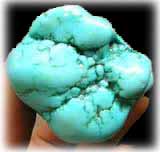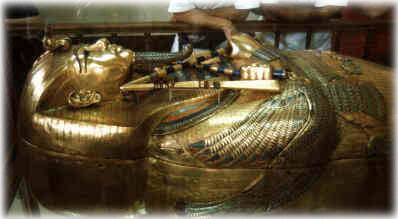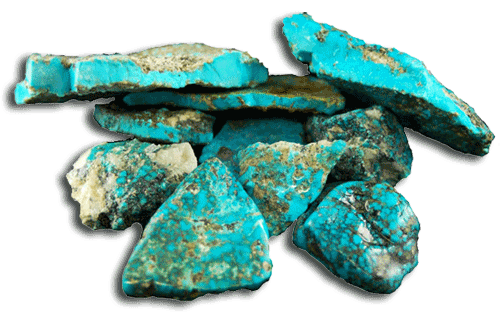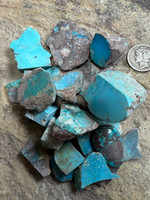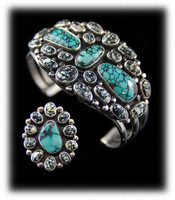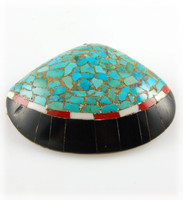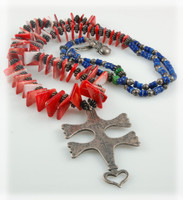 Loading... Please wait...
Loading... Please wait...- 970-759-1040 Text / Voice
- Gift Certificates
- My Account
Currency Displayed in
- Home
- Turquoise Learning Center
- Turquoise Information
- Turquoise History
Categories
Turquoise History
Turquoise History
Turquoise History
Turquoise is one of the most fascinating gemstones on earth, it is also one of the first gemstones found by man, well over 7,500 years ago. Historic records and antiquities prove that Turquoise has adorned the royalty of Ancient Egypt, Persia, Mesopotamia, the Indus Valley, the Aztecs, early Tibetans and ancient Native American Indians. It has also been a favored gemstone in China since the Shang Dynasty. Kings, Pharaohs, Tribal Leaders and historic individuals have adorned themselves with Turquoise for thousands of years, for good reason - Turquoise is one of the most beautiful gemstones on earth.
 Turquoise Cabochons Turquoise Cabochons |
Continue to read the informational page on the History of Turquoise below:
|
For thousands of years, Turquoise has spanned all cultures, prized as a symbol of wisdom, nobility and said to posess the power of immortality. Studies show that native and tribal people around the world have been found to have very similar beliefs about Turquoise. The general belief that they share is that It was put on earth from the great ones above and that it brings good health, happiness and prosperity to its bearer. The stone was used in religion, art, trade, treaty negotiations as well as for adornment. It has been considered by many around the globe to be associated with life itself. Since the discovery of Turquoise; Shamans, Ancient Doctors and Kings have exploited the stone's medicinal potentials. The gemstone has been considered a Talisman for centuries. Turquoise was believed to prevent injury through accident, prevent blindness, stomach disorders, internal bleeding, various ailments and even used for bites and stings from snakes and scorpions. In ancient times Turquoise was ground into a powder, made into a salves and other solutions that was rubbed on or ingested to cure many types of ailments. The gemstone was also worn on warriors armor to protect them, such as the great army of the Roman Empire! |
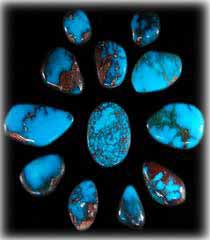 |

Among the Ancient Egyptians, Chinese, Aztecs, Incas of South America, Persians, Romans, and Native North Americans, Turquoise has been a timeless spirit. It seems clear that Turquoise has been considered a stone of life, health and good fortune from ancient times and still today. Turquoise and Turquoise Jewelry is the gemstone investment that has endured the test of time - It has a fantastic history and it will have a wonderful future, it is our pleasure to share our knowledge with you. We are among the most respected authorities on Turquoise in the United States -for over forty years, we have mined, collected and cut turquoise, producing authentic, handmade Turquoise Jewelry in the American Southwest - made in the USA!
Read more about the Spiritual Beliefs of Turquoise | Turquoise Healing | Turquoise Symbolism Throughout History | Turquoise Information
Where Turquoise is located
Turquoise was formed millions of years ago in uncommon arid areas of the world where copper, aluminum phosphates and other specific minerals had conglomerated. Turquoise formations are rare. There are only five areas on earth that have produced significant amounts of Turquoise. Most of the historic sites have been depleted or are no longer producing enough Turquoise for the miners to stay in business. The remaining Turquoise deposits are mined on a seasonal basis and in small scale due to the remoteness of the mines, the difficulty to extract the material from the ground, and local governmental laws. High-grade Turquoise is mined by hand with little or no machinery so as to maintain integrity of the stone. There is a limited amount of natural Turquoise available, mining this gemstone is difficult and there is an ever increasing demand for authentic Turquoise.
China
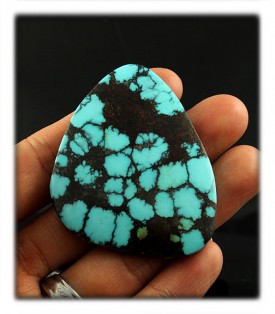 |
The mining of Chinese Turquoise dates back to 1700 B.C. or before, that is over 3,700 years ago. Although many Turquoise mines existed in China, evidence shows that most of the Turquoise used in the ancient world came from the Turks, Persians, and Mongolians in trade through the Silk Road.China has not been a major resouce for Turquoise in the past 3000 years and until recent years there is little trace of native Turquoise coming out of China in the history books. |
|
Chinese Turquoise mines are generally found in the Mashaan and Hubei Province. Turquoise mines in the Mashaan region include: Juangcheng mine, the Jinliantong mine, and the Labashan mine - all in the Zhushan of the Shiyan Prefecture. The most notable mine in the Mashaan Turquoise mining region is the Cloud Mountain mine. Gem-quality Turquoise, in the form of nodules as well as crevice vein, is found in the fractured, silicified limestone of Hubei, Mashaan (near Mongolia), Yunxian and Zhushan province. Turquoise from the Hubei region produces blue as well as green colorations sometimes obtains the brilliant blues long favored by Turquoise enthusiasts. |
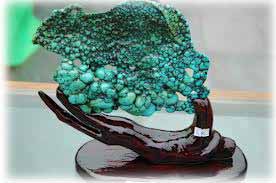 |
|
|
Chinese Turquoise is commonly "stabilized" with a clear epoxy to harden and seal it. This seal makes the stone durable and resistant to the elements. As far as the true physical Turquoiseproperties, some consider Chinese Turquoise, in general, to be of a lower quality because of its color, matrix and reputation for needing to be chemically stabilized. There is beautiful and valuable Turquoise that comes from China in a range of colors as well as matrix configurations - Chinese Turquoise Mines also produce very good "Spiderweb Turquoise" that is very valuable. It is hard to find high-grade Chinese Turquoise for the average buyer - you must educate yourself on Turquoise and you must find an authority on fine Turquoise from China and then it will become available to you. |
Persian / Iranian Turquoise
Persian Turquoise dates back well over 4,000 years and for over 2,000 years, has been considered the "Jewel of the Orient". Until recent years, the region known as Persia has been the main sourse for the highest quality Turquoise in the world. It is known for its clear sky blue to deep rich dark blue colorations, Turquoise from Persia has been one of the most sought after gemstones in the history of the modern world.
|
Persian Turquoise is found in Iran's northeastern city of Neyshabur, located about 150 kilometers west of the city of Mashhad in the Khorasan Razavi Province. This was once a significant location on the ancient Silk Road, linking the Iranian Plateau and China. The Neyshabur Turquoise Mines were located near the old caravan routes which supplied the Turquoise stone to Asia, Europe and America. Archeological findings show that early inhabitants of the Persian Empire had detailed knowledge that Turquoise was used for self-adornment as well as for spiritual and metaphysical purposes. Turquoise was worn around the neck or wrist by individuals as protection against unnatural death. Many believed that looking at this gemstone would strengthen their eyesight and by placing a perfect stone on their eye would cure ailments of their eyes. Ancient Persians believed that Turquoise indicated the health of its owner by turning pale at the time of illness and losing color at the time of death. After death, when a Turquoise stone was given to a loved one, the stone regained its original beauty. Persians believed that reflection of a new moon on Turquoise brought good luck and guarded against evil. Learn more about Persian Turquoise. |
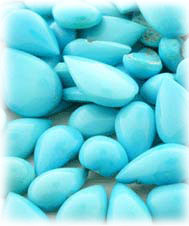 |
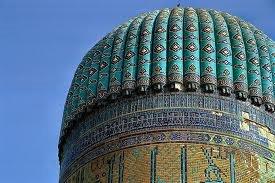 |
In early Iranian architecture, blue Turquoise tiles were used to cover the domes of Mosques because the Persian people believed that Turquoise was also a symbol of heaven on earth. Today, Turquoise is still being mined in Iran, considered sacred, and it is in high demand by Iranian people who appreciate high quality natural Turquoise with no treatment. Quality Turquoise from Iran is very valuable to its own people and for this reason, very difficult to find any quantity being exported out of the country. Today, as well as in the past, Persian Turquoise is known for its clear sky blue to Robbins Egg blue colorations and deep blue with red matrix and red Spiderweb matrix. |
Egytian Turquoise
King Tut's solid gold mask inlaid with Turquoise and other gemstones weighs over 10 kilos of gold.
It is believed that Turquoise was first discovered on the Sinai Peninsula of Egypt over 7,500 years ago. Highly coveted by the Egyptians as a sacred stone with supernatural powers, it was used by healers and worn by Kings and Pharaohs. King Nebkeperura Tutankhamun, "King Tut", the most famous of all Egyptian leaders, was buried in a coffin made of solid gold embellished with Turquoise, Lapis, Carnelian and Onyx gemstones. Also within his burial site was the iconic gold burial mask inlaid with Turquoise. Inside many of the royal tombs of ancient Egypt, Turquoise is found with the kings and queens who hoped to bring it along with them into their afterlife.
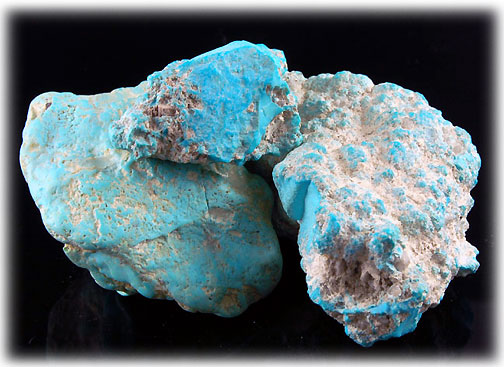
Turquoise was mined by the Egyptians in the Sinai Peninsula, which was considered the "Country of Turquoise" by the native Monitu. There are six mines in the region covering an area of some 650 square kilometers, all on the southwest coast of the peninsula. The most noteworthy of these mines are the Serabit el-Khadim and Wadi Maghareh, they are believed to be the oldest Turquoise mines on earth. The Serabit el-Khadim mine is situated about 4 kilometres from an ancient temple dedicated to Hathor, the "Mistress of Turquoise," "Goddess of Love, Motherhood, Joy and Music," of the predynastic times.
Today, there is little Turquoise mining in Egypt as the majority of the Turquoise found is very soft. Most recently, Egyptian's have begun stabilizing their Turquoise and are seeing good success from this process. Hopefully, in time, we might see more Egyptian Turquoise being mined and traded..
Tibet
|
The Tibetans use Turquoise more than any other gemstone. In Tibet, Turquoise is believed to contain metaphysical powers and that it brings good luck to its bearer. It is widely believed that Turquoise contains healing powers, it is a very spiritual gemstone that most every person wears every day of their life. Most homes in Tibet have an alter of Turquoise, in a prominant location, that watches over their home and gaurds againt harm and evil spirits. Turquoise is worn in rings, bracelets, necklaces, hair beads and as adornments directly on hats and other clothing, Tibetans even use necklaces of felt with Turquoise to adorn their domestic animals. |
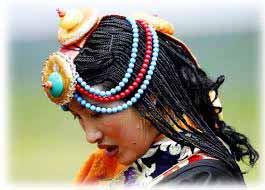 |
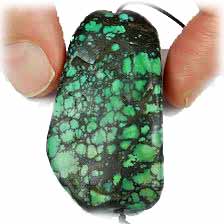 |
Tibet has it's own source of Turquoise usually producing a very hard stone with a green cast and a significant amount of spider webbing. Turquoise is a highly revered item to the Tibetans who rank it in six grades, the most expensive valued well above gold. Every Tibetan wears or carries a piece of Turquoise throughout life, Turquoise is and has been used for currency in many areas of Tibet for thousands of years. Learn more about Tibetan Turquoise. |
United States - American Turquoise
Turquoise was discovered in North America around 200 B.C. by the Native American Indians located in the American Southwest region. Ancient Indians worshiped Turquoise, believing it had great powers and was sent to earth by the fathers of creation. Turquoise was used in most ceremonies and prayer, Medicine Men throughout Meso America relied heavily on Turquoise, native peoples believed Turquoise was a sacred stone. Most ancient tombs of tribal leaders and medicine men in the ancient times had amulets of American Turquoise, they believed in the after life they could take Turquoise with them. There is no question, Turquoise was used for its Spiritual and Metaphysical powers by the natives throughout the America's.
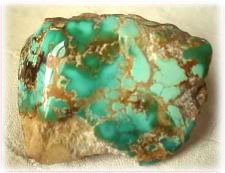 |
Turquoise has been very important to Native Americans throughout time; and when the white man came to America, it became an important and valuable trade item. The Navajo Indians of the American Southwest began making Turquoise Jewelry around 1885 which instantly had great demand in modern U.S. society and beyond. Shortly after 1900 came tourism at the Grand Canyon and Turquoise Jewelry was the main gift or souvenir tourists took home. In the 1930's, Hollywood and movie stars fell in love with Turquoise and Turquoise Jewelry. By the 1970's, the movie industry had solidified great awareness, appreciation and demand for Turquoise Jewelry in United States. In the US people loved all kinds of Turquoise, but especially fell in love with the rarest form of Turquoise, Spiderweb Turquoise. |
In 1980 there were over 200 active Turquoise Mines in the Southwestern United States producing Turquoise to supply the American Turquoise industry, business was booming. A group of American traders went to China in 1985 to discover massive resources of valuable Turquoise that the Chinese had been mining for hundreds of years and discarding due to its impurities. The Americans loved those impurities (spiderweb matrix) and considered the Chinese scrap to be natural Turquoise of the highest quality. Hundreds to thousands of tons were purchased for little money and exported to the United States. This created a major problem in the Turquoise Industry, the Turquoise Traders flooded the American and European Markets with natural Chinese Turquoise. Thise high grade Turquoise started out more expensive than American Turquoise, but after the market was over flooded with the material, the value of Chinese Turquoise became so low that it put almost all of the American Turquoise Miners out of business.

Today, American Turquoise has increased in value more than 100% in the past twelve months; collectible, natural (not treated) Turquoise, 200 - 1000%. The majority of the world's finest-quality Turquoise has come from the United States; however, these supplies of Turquoise have dwindled to an all-time low and the demand for quality American Turquoise Jewelry is at an all-time high - worldwide. We expect the demand for quality American Turquoise Jewelry from the Southwest to increase as it is some of the only handmade Jewelry in the world with real, investment-quality Turquoise.
Where does Turquoise come from in the United States?
|
Arizona is currently the most important producer of Turquoise in the United States, however, the Kingman Mine is the only mine producing Turquoise and cannot provide all of the Turquoise that is needed to supply our Turquoise industry. The Kingman Turquoise mine is the only Turquoise deposit being commercially mined and distributed by the owners. All other Turquoise is much harder to come by and in limited supply. Arizona is also where the Sleeping Beauty Mine is located, however, it closed in 2012 and it will take a tremendous amount of time and money to redevelop the Sleeping Beauty Turquoise mine to a state where it will produce Turquoise once again. Learn more about Arizona Turquoise Mines |
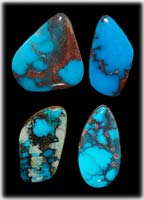 |
Nevada was the country's leading producer of gem grade Turquoise in the past; unfortunately, almost all of the mines have been closed due to the circumstances noted above. Because of the geology of the Nevada Turquoise deposits, the majority of Turquoise produced here is hard and dense - no treatment or enhancement is required. A significant portion of the Nevada material is valuable due to its beautiful Turquoise colors and its brown or black limonite veining, producing what is called "Spiderweb matrix". Nearly all of the Mines in Nevada have been closed since the late 1980's. Learn more about Nevada Turquoise mines
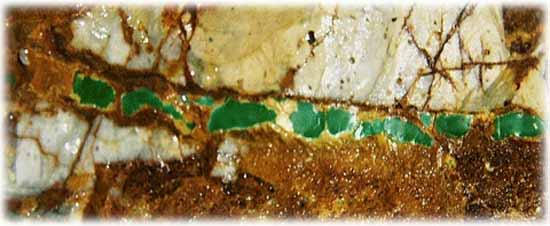
Other states with Turquoise deposits in the USA are California, Colorado, New Mexico and Utah. Learn more about California Turquoise | Learn more about Colorado Turquoise | Learn more about New Mexico Turquoise
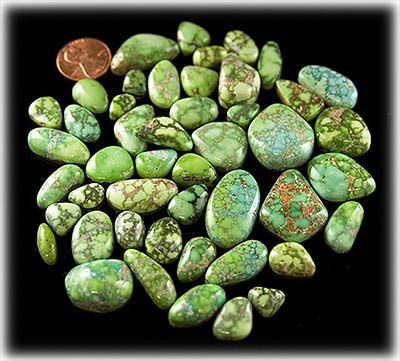
ABOVE: High Grade Natural Carico Lake Turquoise from Nevada
Other Turquoise Deposits
Other notable localities that have deposits of Turquoise, (generally low quality,) include: Afghanistan; Australia; North India; Mexico; Northern Chile; Cornwall; Saxony; Silesia; and Turkestan
Turquoise Treatments
Throughout history royalty, medicine men and spiritual leaders only use natural Turquoise that does not have any treatment, they believed Turquoise had to breath to be of value to their beliefs. In addition, treated Turquoise does not have the value of high grade natural Turqoise as it is not natural - it is enhanced to look like something it is not. If you are interested in Turquoise for its spiritual, metaphysical or investment values, be very careful of what you buy and who you buy it from.
Turquoise is treated to enhance its colour, durability, hardness and to decreased its porosity - many techniques are used to completely alter the material from its natural state. This is necessary for poor quality or inferrior Turquoise so that it can be used for costume or tourist grade jewelry and carvings. Listed below are different treatments commonly used on Turquoise.
Waxing and oiling
Historically, light waxing and oiling were the first treatments used in ancient times, providing a wetting effect, thereby enhancing the colour and lustre. This treatment is more or less acceptable by tradition, especially because oil treated Turquoise is usually of a higher grade to begin with. Oiled and waxed stones are prone to "sweating" under even gentle heat or if exposed to too much sun, and they may develop a white surface film or bloom over time. (With some skill, oil and wax treatments can be restored to its natural state.)
Stabilization
|
Material treated with plastic or water glass is termed "treated, stabilized" or "bonded" Turquoise. This process consists of pressure impregnation of otherwise unsaleable chalky material by epoxy and plastics (such as polystyrene) and water glass (sodium silicate) to produce a wetting effect and improve durability. Plastic and water glass treatments are permanent and cannot be removed, they are considered by some to be too radical of an alteration to remain a valuable gemstone. |
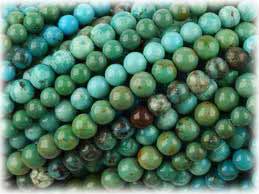 |
Dyeing
The use of Prussian blue and other dyes to make Turquoise uniform or completely change in color is regarded as fraudulent by purists, however, it is done and many consider this exceptable for costume or low cost Jewelry.
Reconstitution
Perhaps the most extreme of treatments is "reconstitution", wherein fragments of fine Turquoise material are powdered and then bonded with resin to form a solid mass. In the trade "reconstituted" Turquoise is often called "block" Turquoise or simply "block." Again, this type of material has no investment value and certainly has no value for spiritual or metaphysical purposes.
Fake Turquoise
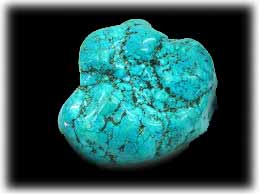 |
The majority of fake Turquoise is made in China. It began in the 1990's when the mining of specific types of Turquoise was becoming hard to find. Chinese manufacturers found Magnisite, Howlite and a few other types of white chalk and began dying them and then stabilizing them with plastic resins to make exactly what they needed for each order. In 2012, they started making fake, (created,) Turquoise with cement, (as in sidewalks,) they have prefected making fake Turquoise to a science. They make moulds of Turquoise Nuggets, Turquoise Beads, Turquoise Stones and Turquoise Statuary and inject the Turquoise colored cement into the moulds. They can make hundreds of kilos of fake Turquoise per hour. Fake Turquoise has no real value other than for cheap immitations. |
Backing
Since fine quality natural Turquoise is often found as thin seams, it may be glued to a base of stronger foreign material as a means of reinforcement - this does not treat the Turquoise itself. These stones are termed "backed," it is standard proceedure in the Southwestern United States to back valuable Turquoise for durability. Backing of Turquoise is not widely known outside of the Southwestern United States jewelry trade. Backing does not diminish the value of high quality Turquoise.
Learn more about Turquoise Grades | Turquoise Colors | Turquoise Treatments and Values
What Our Turquoise Collectors Are Saying:
- Wow, blown away, this Mens High Grade Kingman Turquoise Ring is world class! Tell your family I'm a customer for life. God Bless! - Jacob Murphy - Louisiana
- Dillon, I received my Bisbee Turquoise men's cuff bracelet today...boy, that was quick! It looks great and fits well (your video really helped)... Thanks Again! I will enjoy it and pass it down to one of my sons someday! A++ Turquoise Jewelry - Scott McPherson
- The Broken Arrow Necklace set was very well received, Ithought she was going to sleep in it. Apparently she had seen and admired it in your shop first. When you see the Native American Jewelry artist please thank them for me and tell them that they have a new fan in Tejas. - Micheal Aylott
- The two rings I received, designed by Dillon, have stunning silver settings - truly distinctive and beautiful. I think Dillon's contemporary designs really showcase these rare gemstones and keep the southwest spirit intact - outstanding artisan craftsmanship, and I'm so pleased with them. - Patricia Delabar - Sacremento, California
- Just wanted you to know that I received the ring and it fits perfectly. I couldn't be happier with my genuine Turquoise. Your Turquoise History and Information is second to none. The handmade Turquoise ring is outrageous! It exceeds all expectations. Thank you. - Richard Judd -Connecticut
- Dear Sir, I've got my goods. I've recommeded your shop to a lots of friends of mine, and I'll shop again in your shop. You truly have the best handmade Turquoise jewelry! In China, many people like blue gem from USA (American Turquoise), they are so beautiful and unbeatable. - Regards - Mr. Chu - Shanghai, China
- Just wanted to let you know how pleased I am with my first order with your company. I was looking for earrings for a friend’s 50th (December) birthday and these earrings were perfect with the 5 layers to me representing each decade, and of course turquoise being her birthstone! They have arrived, are perfect, and beautifully done. I also love that the package states made in USA. Thanks so much for a wonderful gift. - Cheri Simon
- I just received my Inlay Sleeping Beauty Ring by Michelle Willie and wanted you to know I am completely satisfied. The ring is everything I had hoped for and Michelle is a wonderful artist. Thank you ever so much. - W.W. Rudolph - Illinois
- The Broken Arrow Earrings arrived today. I love them! They match my necklace and an Orville Tsinnie cuff I have. I am delighted. Thanks for offering these in place of the other pair. I appreciate too, that you gave them to me for the listed price of the first pair of earrings. These are perfect!! Thanks again, I look forward to shopping with you in the future! - Mary
- I got my ring today and I really like it. I wore it to work and it fit perfectly. It's so comfortable I forgot I had it on. Good Job ! I will be ordering more handmade silver jewelry from you again in the future. Thank You Very Much. - Mike Collins - Oklahoma
We invite you to learn more about Turquoise Jewelry and Turquoise by following the links in our Learning Center to other informational pages we have written on different topics directly related to Turquoise History, In addition, we would like to invite you to join our Newsletter - about once every other month we send out a Newsletter to inform our members of what's happening with Durango Silver Company, new products, specials for our members and more. We also have a monthly drawing from our member base to give away free Turquoise Jewelry from our company. Please take a moment to become one of our friends by signing in below. We hope you have enjoyed our presentation on Turquoise History and have gained some useful knowledge from it.




